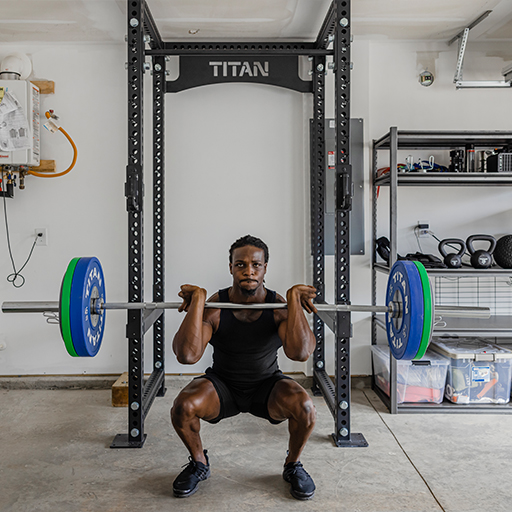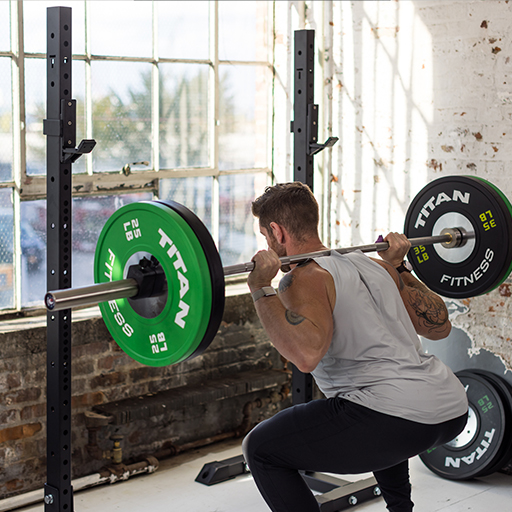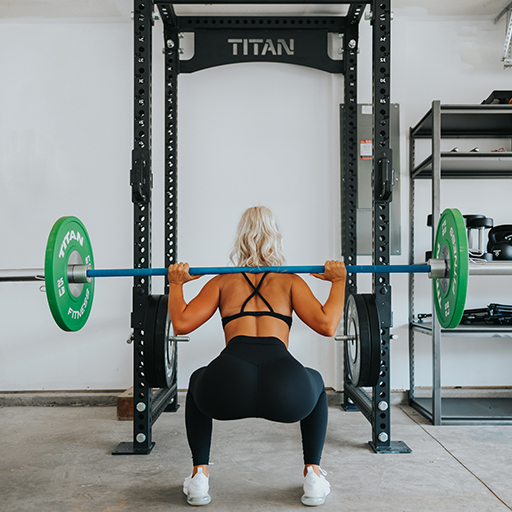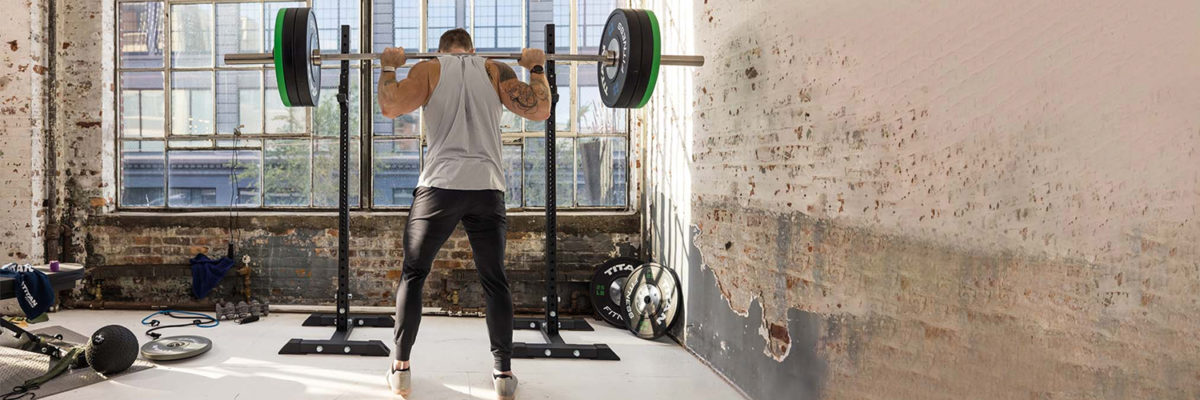Squat stands and power racks are standard equipment for any gym and have become increasingly popular for home gyms as well. Next to barbells and dumbbells, a power rack and squat stand are two of the most essential pieces of strength training equipment you can buy.
But for all their popularity and importance, squat stands and power racks are constantly mistaken for one another. The mix-up is understandable because both power racks and squat stands provide a safe, secure place to rack your barbell while doing squats, bench presses, and other strength training exercises. However, there are distinct differences between squat stands and power racks, and it’s important to understand these differences before you start equipping your home gym.
What is a Power Rack?
A power rack (also called a “power cage”) is comprised of four tall upright metal posts that resemble an open cage. These posts are fitted with J-hooks and may have other features, including:
- Pull-up bars
- Weight horns for bumper plates
- J-hooks (to support different exercises)
- Safety straps
- Band pegs
You can also add extra accessories to a power rack, including weight benches, dip bars, rack-mounted lat tower, knee holders, and cable crossover attachments.

A power rack is essential for weight training, especially if you’re training by yourself and don’t have a spotter. In fact, a power rack acts as a “mechanical spotter” in many ways because it’s equipped with supports for standard and specialty barbells at various points along the posts. These types of supports include J-Hooks and Safety Spotter Arms. J-Hooks hold your barbell at a height you determine to allow for easy lifting based on the exercise you are performing. Safety Spotter Arms is an attachment that allows you to perform heavy lifts with the benefit of catching the barbell if it were to be dropped.
Uses of a Power Rack
A power rack is used for all kinds of strength training routines, including:
Bench presses: With a power rack, you can place the barbell above your chest without worrying about slippage.
Pulley/cable exercises: You can add detachable pulleys, cables, and hooks to your power rack to facilitate a variety of muscle-strengthening exercises.
Squats: You can add horizontal bars at strategic points for a wide range of squat routines.
What is a Squat Stand?
At first glance, a squat stand resembles a power rack. Construction-wise, a squat stand consists of a back stand that, like a power rack, is equipped with J-hooks for holding barbells. Unlike a power rack, however, a squat stand is made up of two metal posts, not four. That’s why some weightlifters also refer to a squat stand as a “half cage.”

Uses of a Squat Stand
Squat stands are mainly designed for two types of exercises, squats and bench presses. For a basic squat with a squat stand, you simply position yourself under the barbell, lift it off the squat stand, step back, and squat. Once you’ve completed your final rep, you step forward and place the barbell back on the squat stand.
What are the Differences Between Squat Stands and Power Racks?
The primary differences between squat stands and power racks can be summed up in two words: versatility and safety.
Power racks are equipped with J-Hooks and safety spotters or safety straps placed along the vertical posts, giving you a multitude of options for barbell placement before and after lifting. As a result, if you fail on a rep, you can quickly replace the barbell without having to drop it to the floor. This reduces the risk of accidents and injuries, enabling you to perform heavy lifts without a spotter. With a power rack, you don’t have to worry about bailing on a lift because your equipment has you covered.
Typically squat stands don’t have this safety feature, so if you have to bail on a lift, you’ll have to drop the barbell all the way back down to the floor. However, Titan Fitness does offer this safety attachment on its squat stands, making them safer and more secure than squat stands without this feature. However, caution should always be practiced when dropping heavy weights.
As for versatility, power racks are built to not only accommodate heavier weights; they’re also designed for add-on attachments such as pull-up bars, cables, and pulleys, enabling you to do a wide range of exercises. On the other hand, squat stands are built just for squats and bench presses. They aren’t strong enough to accommodate heavier weights or other types of pulley/cable exercises.
Benefits of a Power Rack
- More versatility is achieved with power racks because they accommodate a wider range of exercises. In addition to squats and bench presses, you can do pull-ups, chin-ups, deadlifts, and much more.
- Power racks feature horizontal adjustable safety bars placed on each side, so you have optimum support during lifts.
- Power racks hold significantly more weight than squat stands, so there’s less risk when using heavy bumper plates.
- You can add a variety of safety attachments to your power rack for added stability and security.

Benefits of a Squat Stand
- Squat stands take up considerably less room and don’t require a high ceiling in your home gym. Titan Fitness offers squat stands in both short (72″) and tall (91″) sizes to accommodate an assortment of home gyms.
- Squat stands are cheaper. For example, you can get a top-quality squat stand at Titan Fitness for under $270.
- If you only perform bench presses and squats without the need for extra-heavy bumper plates, then squat stands can be an affordable, compact option.

If you’re ready to optimize your strength training regimen with the best home gym equipment, you’ll find a power rack or squat stand can take your workout routine to a whole new level. With a power rack, you can do dozens of routines, enabling you to perform a full weight-strengthening workout — but if you have limited space, a squat stand can help you maximize those all-important squats and bench presses. Whichever you decide to buy, Titan Fitness is happy to answer any questions you might have. And don’t forget to visit our website, where you can learn about all the latest fitness equipment and accessories for your home gym.


